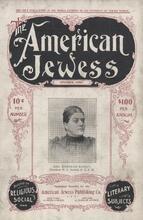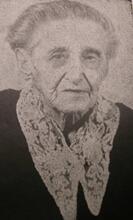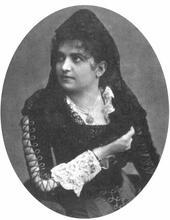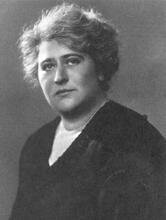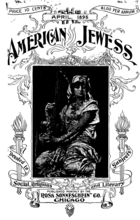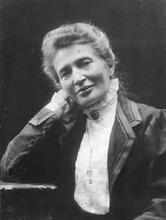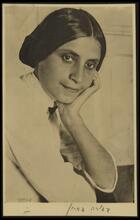Die Deborah
Title page of Die Deborah, an influential American Jewish newspaper published in German for women, published in January 1901. The page reads, translated from German:
"Forward, my soul, forward with strength!
A German-American weekly to promote Jewish interests in community, school and home.
Founded in 1855 by Isaac M. Wise.
Published by a union of Jewish authors."
Courtesy of HathiTrust.
As part of the most important German-Jewish newspaper in America The American Israelite, Die Deborah propagated a program of German identity, bourgeois culture, and Jewish Reform to a female audience. The paper published works by both men and women, literature and essays on Jewish religion, culture, and history, and debates on education. Considering women integral to the Jewish community as its spiritual and moral standard-bearers, Die Deborah advocated religious and secular education for women and greater participation in the synagogue. In its later years, the tone of the paper became more progressive, supporting women’s suffrage and praising women who pursued professional careers and their contributions to society outside of the home.
Introduction
“German Israelites! So little is done in this country for the instruction and the intellectual entertainment of the ladies that we believe Die Deborah will be welcome to everybody. … [She will form] the connecting link in the chain of Judaism between America and Germany; she will give important service to those who do not read English and she will be welcome to everybody who venerates Judaism and who loves his mother tongue.” With these words, the leading Reform rabbi, Isaac Mayer Wise (1819–1900) of Cincinnati, introduced the periodical Die Deborah in 1855. Wise edited Die Deborah as a German-language supplement of the English-language weekly The Israelite (from 1874 on, The American Israelite). Die Deborah disbanded in 1902, two years after Wise died.
As the most important German Jewish newspaper in America, Die Deborah propagated a program of German identity, of bourgeois culture, and of Jewish Reform in which women were assigned a strategic place. The paper published essays on Jewish religion, culture, and history, and debates on education. Literature, mostly ghetto novels, was given a privileged place. While Die Deborah reported on Jewish issues from all over the world, it focused on news from Germany, and it gave special attention to the cultural life of the German immigrant community in America.
The contributors to Die Deborah understood their Germanness not as an ethnic identity, but as a cultural asset. They believed in the German notion of Bildung (education)—the harmonious formation of the intellect and of the character—and in a democratic and progressive society with high ethical standards. The articles in Die Deborah insisted that true religiosity and cultural refinement could be expressed best in the German language. In fact, long after Jewish immigrants from German-speaking lands had adopted English in other realms of life, they still considered German the language of the synagogue, the language of spirituality and morality, the language of the house, and the language of women.
Women’s Roles According to Die Deborah
Nineteenth-century middle-class culture ascribed to women a greater sense of religiosity and morality than men. In the German concept of Bildung, notions of religiosity and cultural distinction converged. Die Deborah addressed Jewish women as “priestesses of the home,” whose excellence was considered essential for the moral standard of the family, for bourgeois gentility, and for the survival of Judaism. Being the educator of Jewish children was a woman’s holiest task. A Jewish mother should encourage her child to be charitable, grateful, truthful, gentle, orderly, and punctual, and she should always be a good example. She should accustom her child to the synagogue and should read from the Bible or from religious tractates at home. According to Die Deborah, such behavior was apt to preserve “the venerable customs of Judaism.”
Clearly, what was propagated as the virtues of Jewish family life were class-specific, bourgeois values that had little to do with traditional Jewish housekeeping. By defining the Jewish religion not as a culture of male learning, such as traditional Judaism tended to perceive itself, but as a moral institution, Jewish women gained great prominence. For the contributors to Die Deborah, “the daughter of Israel” was the pillar on which the Jewish religion rested. Die Deborah was persistently concerned with religious education and secular schooling for Jewish women, and the journal advocated as well a greater role for women in the synagogue.
Many series portrayed women as Jewish national heroes and praised their achievements in the history of their people. In order to fulfill the legacy of historical Judaism, Die Deborah claimed, the social position of Jewish women needed to be improved. However, until the last decades of the nineteenth century, how far such an emancipation of Jewish women should go was highly controversial. Should, for example, girls leave the home for the sake of education, and should women’s supposedly benevolent influence extend beyond the domestic setting? The contributors to Die Deborah saw education for Jewish girls as primarily moral training that would enable young women to withstand the seductions of materialism and atheism. Then, they would not only remain within Judaism, but would also infuse their children with morality.
A More Progressive Outlook in Later Years
The ideal of female domesticity, marriage, and motherhood remained the central point of reference in Die Deborah throughout its existence, but from the 1880s on, its emphasis on women’s education and accomplishments of women in Jewish history encouraged women’s activities outside the home, including professional careers. By then, Die Deborah, and also The American Israelite, were addressing the small elite of America’s college-educated women. Moreover, Jewish women began to contribute in significant numbers to both journals. Male and female authors not only defended women doctors, lawyers, and other professionals, but they also expressed great pride in these Jewish women, claiming that a woman’s education did not endanger, but enhanced, married life.
Finally, Die Deborah and The American Israelite supported women’s suffrage. In fact, in the 1890s, the publications were similar in tone and content to the feminist The American Jewess, America’s first journal edited by a Jewish woman, Rosa Sonneschein. Sonneschein had been married to Rabbi Solomon Hirsch Sonneschein, who was a close friend and coworker of Isaac Mayer Wise. However, Die Deborah and The American Israelite kept their distance from natural rights feminism. The women’s rights that the journals advocated stemmed from Jewish women’s alleged excellence as mothers and wives, and from their pivotal role in promoting religiosity, morality, and propriety.
The importance of Die Deborah declined after a few decades, when Jewish immigrants from German-speaking lands and their children preferred to read an English-language, rather than a German-language, newspaper. Women’s issues, as well, were increasingly to be found in The American Israelite. This shift from Die Deborah to The American Israelite not only reflects Jewish integration into American society and culture, it also documents how German Jewish women found their way into the world of women’s clubs, philanthropy, and middle-class feminism. Early American feminism, which was interconnected with evangelism, temperance, and Christian abolitionism, had little appeal for Jewish women. German cultural patterns, upward mobility, and an emphasis on women’s importance in a modernized Judaism shaped the trajectory from enlightened ideals of Jewish womanhood of the 1850s to the “New Jewish Woman” of the turn of the century.
Die Deborah. Complete set on microfilm, Hebrew Union College, Cincinnati, Ohio.
incomplete set, New York Public Library.
Friedenberg, Albert. “Main Currents of American Jewish Journalism.” The Reform Advocate (May 27, 1916): 503–523.
Goldman, Karla. “The Ambivalence of Reform Judaism: Kaufmann Kohler and the Ideal Jewish Woman.” American Jewish History 79, no. 4 (1990): 477–499.
Goren, Arthur A. “The Jewish Press.” In The Ethnic Press in the United States: A Historical Analysis and Handbook, edited by Sally M. Miller (1987): 203–228.
Hyman, Paula E. Gender and Assimilation in Modern Jewish History: The Roles and Representation of Women (1995).
Kaplan, Marion A. “Priestess and Hausfrau: Women and Tradition in the German-Jewish Family.” In The Jewish Family: Myths and Reality, edited by Steven M. Cohen and Paula Hyman (1986): 62–81.
Kuzmack, Linda Gordon. Woman’s Cause: The Jewish Woman’s Movement in England and the United States, 1881–1933 (1990).
Meyer, Michael A. “German-Jewish Identity in Nineteenth-Century America.” In The American Jewish Experience, edited by Jonathan Sarna (1986).
Otto, Kerstin. “The Image of Women in Isaac M. Wise’s ‘Die Deborah’, 1855–1874.” Master’s thesis, University of Cincinnati (1993).
Vierhaus, Rudolf. “Bildung.” Geschichtliche Grundbegriffe: Historisches Lexikon zur politish-sozialen Sprache in Deutschland, edited by Otto Brunner, Werner Conze, and Reinhart Koselleck (1972).
Wise, Isaac Mayer. Reminiscences. Edited by David Philipson (1901).


